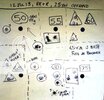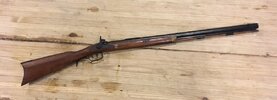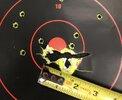I am kinda confused about this process especially about shooting random shots, care to break that down in a little more detail?
Here's what I said on Page 1:
"
Note -
One does NOT shoot all of one charge at once, but shoot them in a random pattern, as then 'statistically' you will have normalized the data by eliminating YOUR bias and spreading any human-induced variation across ALL of the shots and groups.
Examples of such bias are your aim/hold, light on the target, cheek and/or shoulder position or pressure, yanking the trigger or like when you begin to shoot poorly towards the end when tired. Any such factor - independent of the load - could adversely influence or bias any ot the last group's results. Statistically said, shooting them in a round-robin manner thus significantly increases the confidence you can place in the results. For consistency, I pre-load the charges in plastic tubes marked with the charge weight."
Let's say your going to start @ 50-grains and shoot 50, 55, 60 and 65-grains.
Do NOT shoot all of the group of 50-grains before you go onto other charges. Which is WHY I make them up ahead of time at home, I use plastic test tubes with caps, but just makes simple/rolled paper cartridges.
Vary the next one you shoot ... start anywhere ... shoot one 60g load at the bullseye marked for the 60g group, then shoot one 50g at the 50g target, then one 55g at the 55g bullseye, and so on ... until you've shot 3 or 5 at each bullseye.
This normalizes any shooter influenced bias.
Try it, it really works! Like I said, someone was arguing with me about it, so I offered to put $1,000 down on the table where I could find a better group than what they may have had ... and
VOILA ... they did! I didn't take
their money, haha, as I'm just trying to educate people about 'nodes' and the benefits they offer IF/when you identify them. The node is a 'target' load range to further play with (only if you want to, some might be happy with what they get). Like try a few grains lower or higher and with more shots in the group to find YOUR best group, for that fire lock, that patch, that lube and then the charge.
Change
any of them and likely you'll need to repeat the sequence. Note I also expressly use a 6 o'clock hold when doing this, as you are shooting for groups and many studies have proven that sight picture to be the optinum one to use whilst shooting for groups. One can adjust their point of impact, vs. their point of aim, later. Below is the 1st time I ever tried it (over 10-years ago now!) and I've done it since on multiple DOZENS of arms, BP and centerfire, for me and others. Heck, I even do it for rimfire, but the only thing i changes is the brand used (barrel cleaned between brands, and 5-shots shot into the berm to season the bore to the new brand bullet's lube).
In this case below it was a 65-cal 54" barreled early French flintlock
fusil de boucanier. I continued on with
heavier charges and also identified the tighest shootin' group (ragged 1-hole group!) using 1Fg charges around 100-grains. On this one, both 55 and 75 showed promise., but look for yourselves how the other charges
threw shots out wide because the barrel was whipping so much after the powder ignition and as the ball progressed down the barrel.






 Can you believe an 8mm Mauser round didn't punch through from a distance of about three feet? Might be something to think about when talking about going after Mr Griz with a PRB.
Can you believe an 8mm Mauser round didn't punch through from a distance of about three feet? Might be something to think about when talking about going after Mr Griz with a PRB.